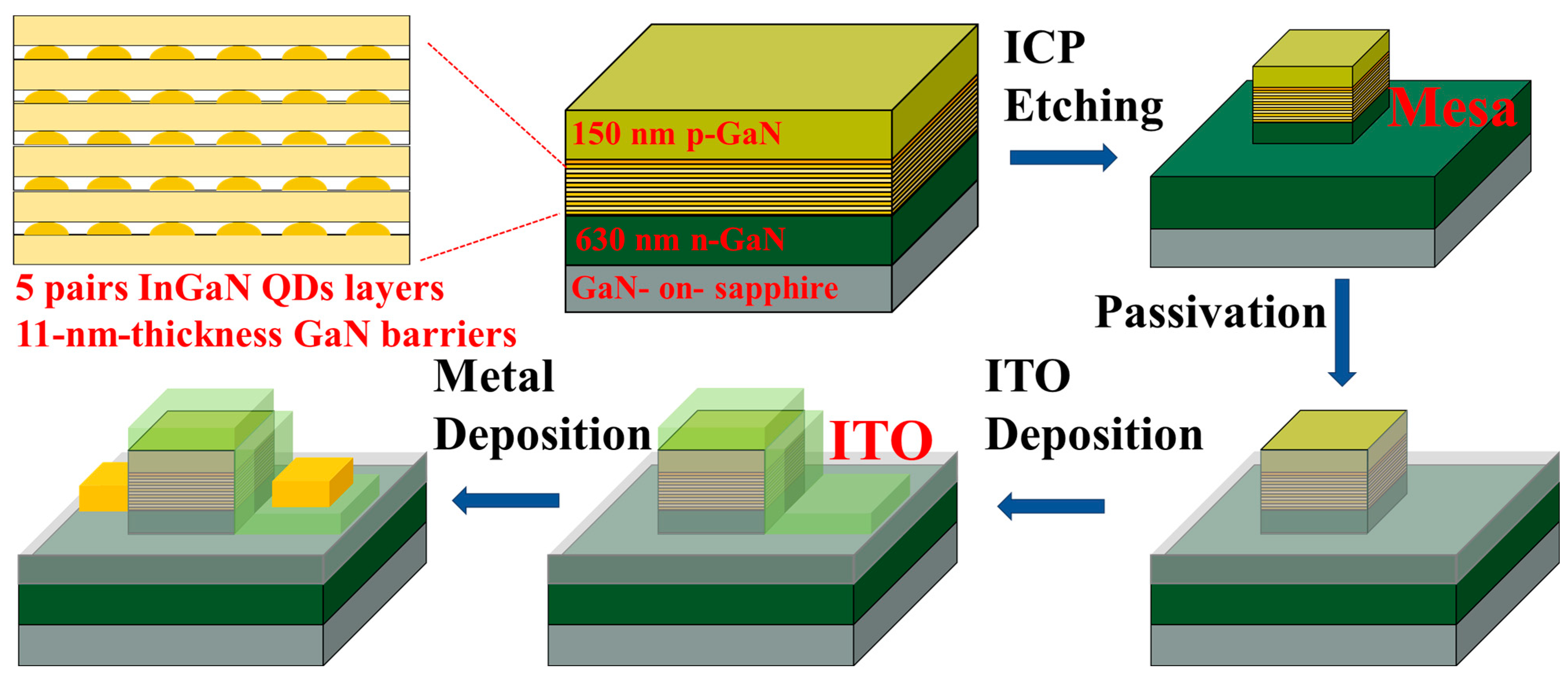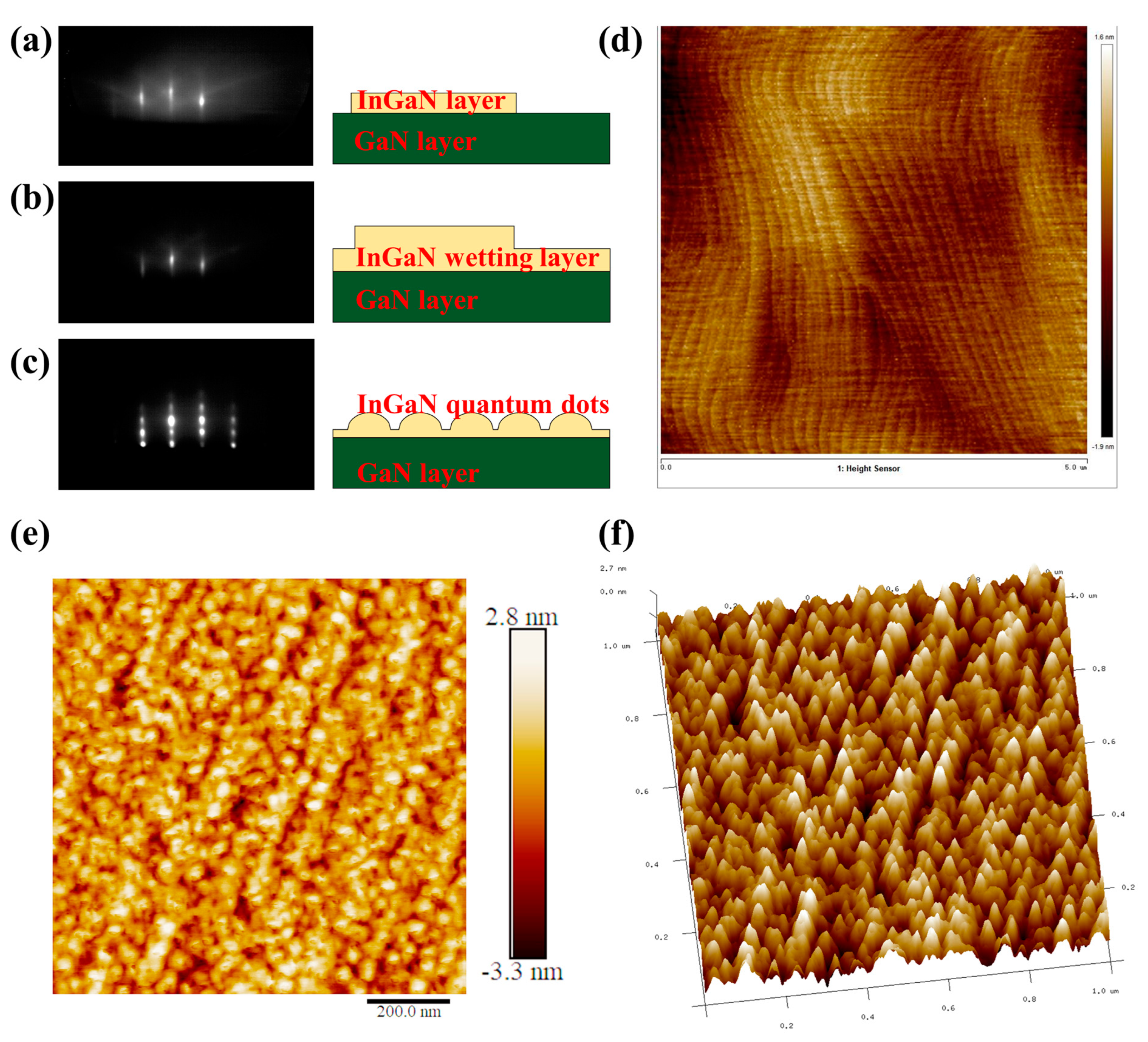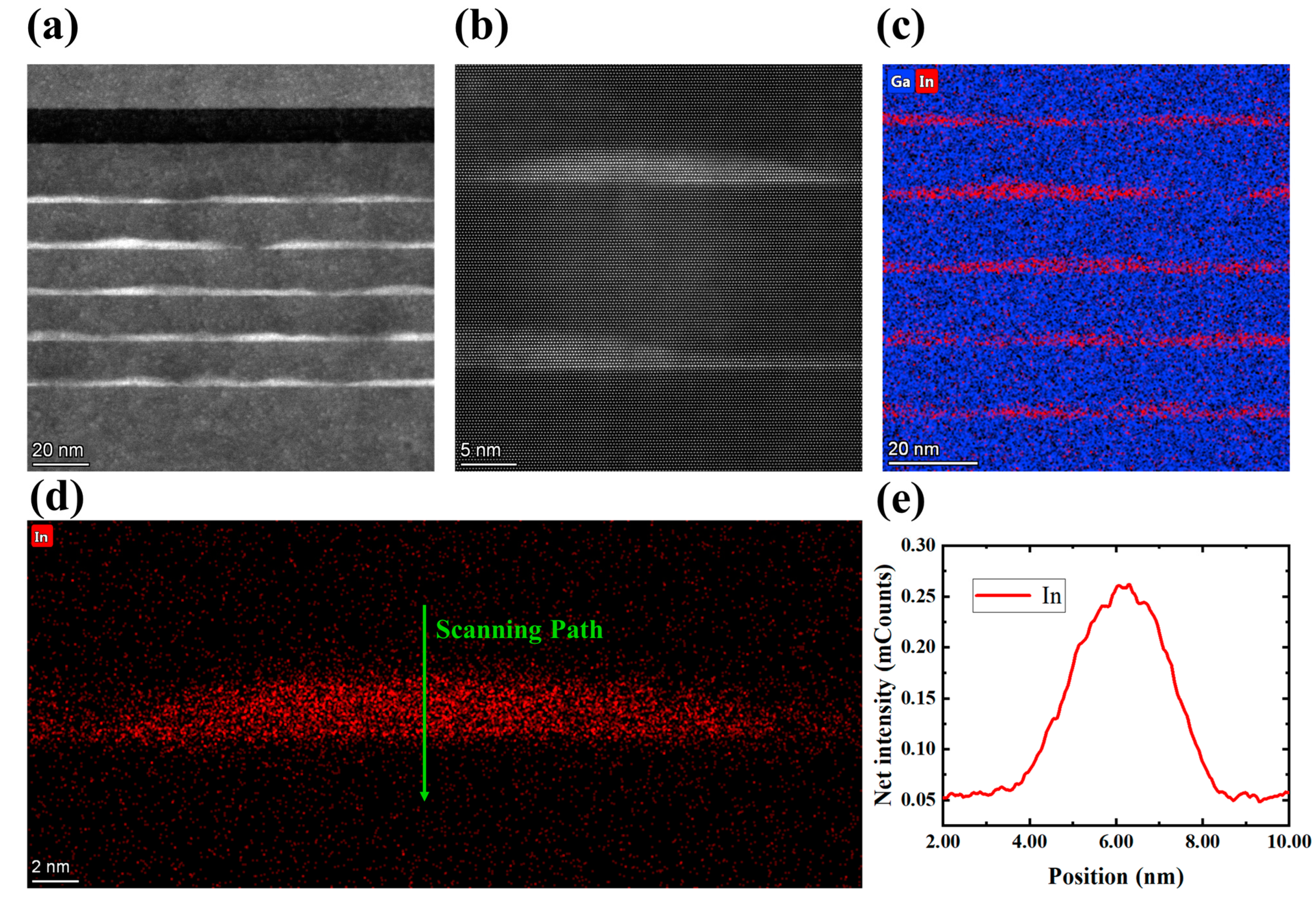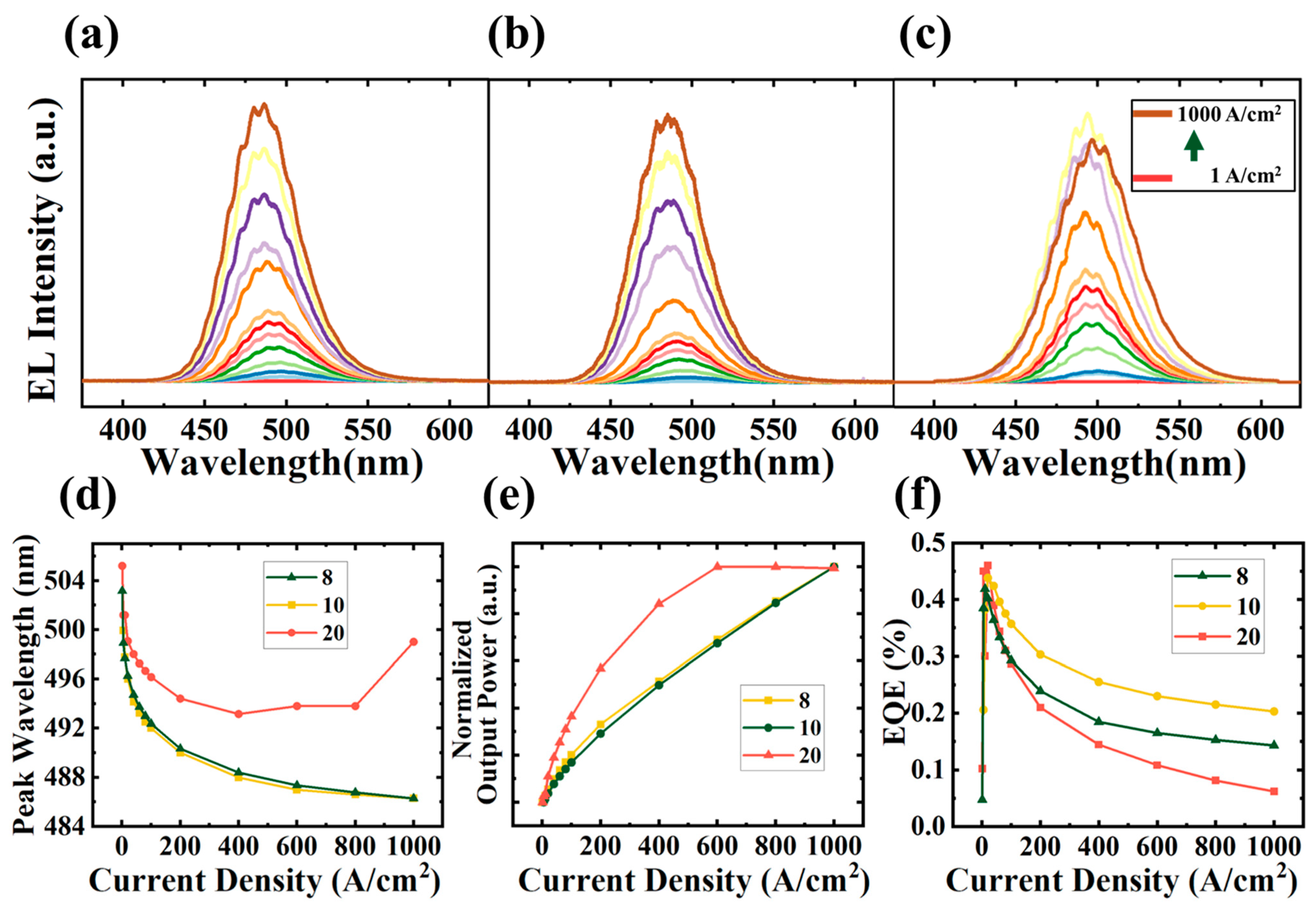Investigation on the Optical Properties of Micro-LEDs Based on InGaN Quantum Dots Grown by Molecular Beam Epitaxy
Abstract
1. Introduction
2. Experiment Details
2.1. Growth of InGaN QD-Based LED Wafers
2.2. Device Fabrication
2.3. Measurements of Micromorphology and Optical Properties
3. Results and Discussion
3.1. Morphology and Optical Properties of InGaN QDs
3.2. Optical Properties of InGaN QD Based Micro-LEDs
4. Conclusions
Author Contributions
Funding
Data Availability Statement
Acknowledgments
Conflicts of Interest
References
- Parbrook, P.J.; Corbett, B.; Han, J.; Seong, T.Y.; Amano, H. Micro-Light Emitting Diode: From Chips to Applications. Laser Photonics Rev. 2021, 15, 2000133. [Google Scholar] [CrossRef]
- Smith, J.M.; Ley, R.; Wong, M.S.; Baek, Y.H.; Kang, J.H.; Kim, C.H.; Gordon, M.J.; Nakamura, S.; Speck, J.S.; DenBaars, S.P. Comparison of size-dependent characteristics of blue and green InGaN microLEDs down to 1 μm in diameter. Appl. Phys. Lett. 2020, 116, 071102. [Google Scholar] [CrossRef]
- Wu, T.; Sher, C.-W.; Lin, Y.; Lee, C.-F.; Liang, S.; Lu, Y.; Chen, S.-W.H.; Guo, W.; Kuo, H.-C.; Chen, Z. Mini-LED and Micro-LED: Promising Candidates for the Next Generation Display Technology. Appl. Sci. 2018, 8, 1557. [Google Scholar] [CrossRef]
- Choi, H.W.; Liu, C.; Gu, E.; McConnell, G.; Girkin, J.M.; Watson, I.M.; Dawson, M.D. GaN micro-light-emitting diode arrays with monolithically integrated sapphire microlenses. Appl. Phys. Lett. 2004, 84, 2253–2255. [Google Scholar] [CrossRef]
- Huang, Y.G.; Hsiang, E.L.; Deng, M.Y.; Wu, S.T. Mini-LED, Micro-LED and OLED displays: Present status and future perspectives. Light-Sci. Appl. 2020, 9, 105. [Google Scholar] [CrossRef] [PubMed]
- Sheen, M.; Ko, Y.; Kim, D.U.; Kim, J.; Byun, J.H.; Choi, Y.; Ha, J.; Yeon, K.Y.; Kim, D.; Jung, J.; et al. Highly efficient blue InGaN nanoscale light-emitting diodes. Nature 2022, 608, 56–61. [Google Scholar] [CrossRef]
- Chen, Z.; Yan, S.K.; Danesh, C. MicroLED technologies and applications: Characteristics, fabrication, progress, and challenges. J. Phys. D Appl. Phys. 2021, 54, 123001. [Google Scholar] [CrossRef]
- Lin, J.Y.; Jiang, H.X. Development of microLED. Appl. Phys. Lett. 2020, 116, 100502. [Google Scholar] [CrossRef]
- Jin, S.X.; Li, J.; Lin, J.Y.; Jiang, H.X. InGaN/GaN quantum well interconnected microdisk light emitting diodes. Appl. Phys. Lett. 2000, 77, 3236–3238. [Google Scholar] [CrossRef]
- Jin, S.X.; Li, J.; Li, J.Z.; Lin, J.Y.; Jiang, H.X. GaN microdisk light emitting diodes. Appl. Phys. Lett. 2000, 76, 631–633. [Google Scholar] [CrossRef]
- Jain, S.C.; Willander, M.; Narayan, J.; Van Overstraeten, R. III-nitrides: Growth, characterization, and properties. J. Appl. Phys. 2000, 87, 965–1006. [Google Scholar] [CrossRef]
- Ding, K.; Avrutin, V.; Izyumskaya, N.; Ozgur, U.; Morkoc, H. Micro-LEDs, a Manufacturability Perspective. Appl. Sci. 2019, 9, 1206. [Google Scholar] [CrossRef]
- Lu, S.Q.; Li, J.C.; Huang, K.; Liu, G.Z.; Zhou, Y.H.; Cai, D.J.; Zhang, R.; Kang, J.Y. Designs of InGaN Micro-LED Structure for Improving Quantum Efficiency at Low Current Density. Nanoscale Res. Lett. 2021, 16, 99. [Google Scholar] [CrossRef] [PubMed]
- Itoh, H.; Watanabe, S.; Goto, M.; Yamada, N.; Misra, M.; Kim, A.Y.; Stockman, S.A. Current dependence of in-plane electroluminescence distribution of InxGa1-xN/GaN multiple quantum well light emitting diodes. Jpn. J. Appl. Phys. Part 2 Lett. 2003, 42, L1244–L1247. [Google Scholar] [CrossRef]
- Yang, F.; Xu, Y.; Li, L.; Cai, X.; Li, J.J.; Tao, J.H.; Zheng, S.N.; Cao, B.; Xu, K. Optical and microstructural characterization of Micro-LED with sidewall treatment. J. Phys. D Appl. Phys. 2022, 55, 435103. [Google Scholar] [CrossRef]
- Huang, Y.; Tan, G.; Gou, F.; Li, M.C.; Lee, S.L.; Wu, S.T. Prospects and challenges of mini-LED and micro-LED displays. J. Soc. Inf. Disp. 2019, 27, 387–401. [Google Scholar] [CrossRef]
- Zhang, M.; Bhattacharya, P.; Guo, W. InGaN/GaN self-organized quantum dot green light emitting diodes with reduced efficiency droop. Appl. Phys. Lett. 2010, 97, 011103. [Google Scholar] [CrossRef]
- Senes, M.; Smith, K.L.; Smeeton, T.M.; Hooper, S.E.; Heffernan, J. Strong carrier confinement and negligible piezoelectric effect in InGaN/GaN quantum dots. Phys. E-Low-Dimens. Syst. Nanostruct. 2008, 40, 2066–2068. [Google Scholar] [CrossRef]
- Senes, M.; Smith, K.L.; Smeeton, T.M.; Hooper, S.E.; Heffernan, J. Strong carrier confinement in InxGa1-xN/GaN quantum dots grown by molecular beam epitaxy. Phys. Rev. B 2007, 75, 045314. [Google Scholar] [CrossRef]
- Raun, A.; Hu, E. Ultralow threshold blue quantum dot lasers: What’s the true recipe for success? Nanophotonics 2021, 10, 23–29. [Google Scholar] [CrossRef]
- Lv, W.B.; Wang, L.; Wang, J.X.; Hao, Z.B.; Luo, Y. InGaN/GaN multilayer quantum dots yellow-green light-emitting diode with optimized GaN barriers. Nanoscale Res. Lett. 2012, 7, 617. [Google Scholar] [CrossRef] [PubMed]
- Bartel, T.; Dworzak, M.; Strassburg, M.; Hoffmann, A.; Strittmatter, A.; Bimberg, D. Recombination dynamics of localized excitons in InGaN quantum dots. Appl. Phys. Lett. 2004, 85, 1946–1948. [Google Scholar] [CrossRef]
- Park, I.K.; Kwon, M.K.; Seo, S.B.; Kim, J.Y.; Lim, J.H.; Park, S.J. Ultraviolet light-emitting diodes with self-assembled InGaN quantum dots. Appl. Phys. Lett. 2007, 90, 111116. [Google Scholar] [CrossRef]
- Zhao, C.; Tang, C.W.; Lai, B.; Cheng, G.; Wang, J.; Lau, K.M. Low-efficiency-droop InGaN quantum dot light-emitting diodes operating in the “green gap”. Photonics Res. 2020, 8, 750–754. [Google Scholar] [CrossRef]
- Wang, L.; Wang, L.; Chen, C.J.; Chen, K.C.; Hao, Z.B.; Luo, Y.; Sun, C.Z.; Wu, M.C.; Yu, J.D.; Han, Y.J.; et al. Green InGaN Quantum Dots Breaking through Efficiency and Bandwidth Bottlenecks of Micro-LEDs. Laser Photonics Rev. 2021, 15, 2000406. [Google Scholar] [CrossRef]
- Kong, X.; Albert, S.; Bengoechea-Encabo, A.; Sanchez-Garcia, M.A.; Calleja, E.; Trampert, A. Lattice pulling effect and strain relaxation in axial (In, Ga)N/GaN nanowire heterostructures grown on GaN-buffered Si(111) substrate. Phys. Status Solidi A–Appl. Mater. Sci. 2015, 212, 736–739. [Google Scholar] [CrossRef]
- Hiramatsu, K.; Kawaguchi, Y.; Shimizu, M.; Sawaki, N.; Zheleva, T.; Davis, R.F.; Tsuda, H.; Taki, W.; Kuwano, N.; Oki, K. The composition pulling effect in MOVPE grown InGaN on GaN and AlGaN and its TEM characterization. MRS Internet J. Nitride Semicond. Res. 1997, 2, U3–U12. [Google Scholar] [CrossRef]
- Jho, Y.D.; Yahng, J.S.; Oh, E.; Kim, D.S. Field-Dependent carrier decay dynamics in strained InxGa1-xN/GaN quantum wells. Phys. Rev. B 2002, 66, 035334. [Google Scholar] [CrossRef]
- Tian, P.F.; McKendry, J.J.D.; Herrnsdorf, J.; Watson, S.; Ferreira, R.; Watson, I.M.; Gu, E.D.; Kelly, A.E.; Dawson, M.D. Temperature-dependent efficiency droop of blue InGaN micro-light emitting diodes. Appl. Phys. Lett. 2014, 105, 171107. [Google Scholar] [CrossRef]
- Lin, Y.; Gao, Y.L.; Lu, Y.J.; Zhu, L.H.; Zhang, Y.; Chen, Z. Study of temperature sensitive optical parameters and junction temperature determination of light-emitting diodes. Appl. Phys. Lett. 2012, 100, 202108. [Google Scholar] [CrossRef]





Disclaimer/Publisher’s Note: The statements, opinions and data contained in all publications are solely those of the individual author(s) and contributor(s) and not of MDPI and/or the editor(s). MDPI and/or the editor(s) disclaim responsibility for any injury to people or property resulting from any ideas, methods, instructions or products referred to in the content. |
© 2023 by the authors. Licensee MDPI, Basel, Switzerland. This article is an open access article distributed under the terms and conditions of the Creative Commons Attribution (CC BY) license (https://creativecommons.org/licenses/by/4.0/).
Share and Cite
Gu, Y.; Gong, Y.; Zhang, P.; Hua, H.; Jin, S.; Yang, W.; Zhu, J.; Lu, S. Investigation on the Optical Properties of Micro-LEDs Based on InGaN Quantum Dots Grown by Molecular Beam Epitaxy. Nanomaterials 2023, 13, 1346. https://doi.org/10.3390/nano13081346
Gu Y, Gong Y, Zhang P, Hua H, Jin S, Yang W, Zhu J, Lu S. Investigation on the Optical Properties of Micro-LEDs Based on InGaN Quantum Dots Grown by Molecular Beam Epitaxy. Nanomaterials. 2023; 13(8):1346. https://doi.org/10.3390/nano13081346
Chicago/Turabian StyleGu, Ying, Yi Gong, Peng Zhang, Haowen Hua, Shan Jin, Wenxian Yang, Jianjun Zhu, and Shulong Lu. 2023. "Investigation on the Optical Properties of Micro-LEDs Based on InGaN Quantum Dots Grown by Molecular Beam Epitaxy" Nanomaterials 13, no. 8: 1346. https://doi.org/10.3390/nano13081346
APA StyleGu, Y., Gong, Y., Zhang, P., Hua, H., Jin, S., Yang, W., Zhu, J., & Lu, S. (2023). Investigation on the Optical Properties of Micro-LEDs Based on InGaN Quantum Dots Grown by Molecular Beam Epitaxy. Nanomaterials, 13(8), 1346. https://doi.org/10.3390/nano13081346



